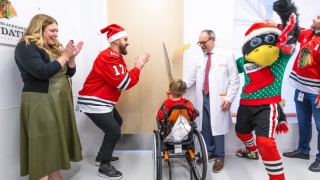Body
Problems with temperature regulation happen in people with cervical and high thoracic spinal cord injuries. Body temperature may change somewhat with the air temperature: if you are in a cold place, body temperature will drop; if you are in a very warm place, body temperature will rise. In a hot environment, the body normally sends a signal saying it is hot through the brain and spinal cord, and overheating is prevented by telling the body to cool down by sweating. In a cold environment, these signals keep you warm by causing the blood vessels to constrict and the body to shiver.
When you have a spinal cord injury, your body and brain may not send or receive these signals properly, causing the body to experience hyperthermia (too hot) or hypothermia (too cold). The normal responses to hot and cold, such as sweating or shivering, may still occur, but only above your level of injury. They are not as effective if the whole body does not react to them. You may not experience the feeling of hot and cold as you used to, but your body is still sensing and responding to it. It is important to be aware that your body can be more sensitive to changes in temperature and prepare accordingly. You should also pay attention to the other signals your body sends you about its temperature, not just sensation.
To prevent temperature-related issues, avoid extreme heat or cold. In hot weather, limit sun exposure and stay hydrated. In cold weather, wear warm layers and keep hands and feet dry to prevent frostbite. Symptoms of overheating include headache, dizziness, nausea, and flushed skin. Cold exposure may cause chills and teeth chattering.
If overheated, move to a cooler space, remove extra clothing, sponge off with cool water, and drink fluids. If chilled, use blankets, increase room temperature slightly, and drink warm liquids. Avoid using ice packs or heating pads, as reduced sensation may lead to burns or frostbite. Take breaks from extreme environments to help your body regulate. If temperature remains abnormal, consult a doctor to rule out other causes like infection.
Body
This content is for informational purposes only and may not be comprehensive. Information contained does not imply an endorsement from Shirley Ryan AbilityLab, and does not replace the advice of a qualified healthcare professional. See here for further details.© Shirley Ryan AbilityLab (formerly Rehabilitation Institute of Chicago). Henry B. Betts LIFE Center – (312) 238-5433 – https://www.sralab.org/lifecenter.



